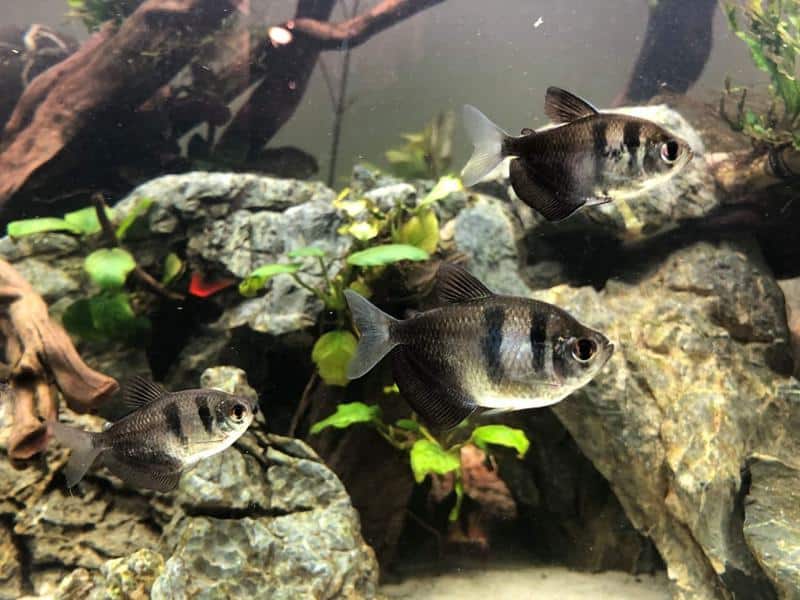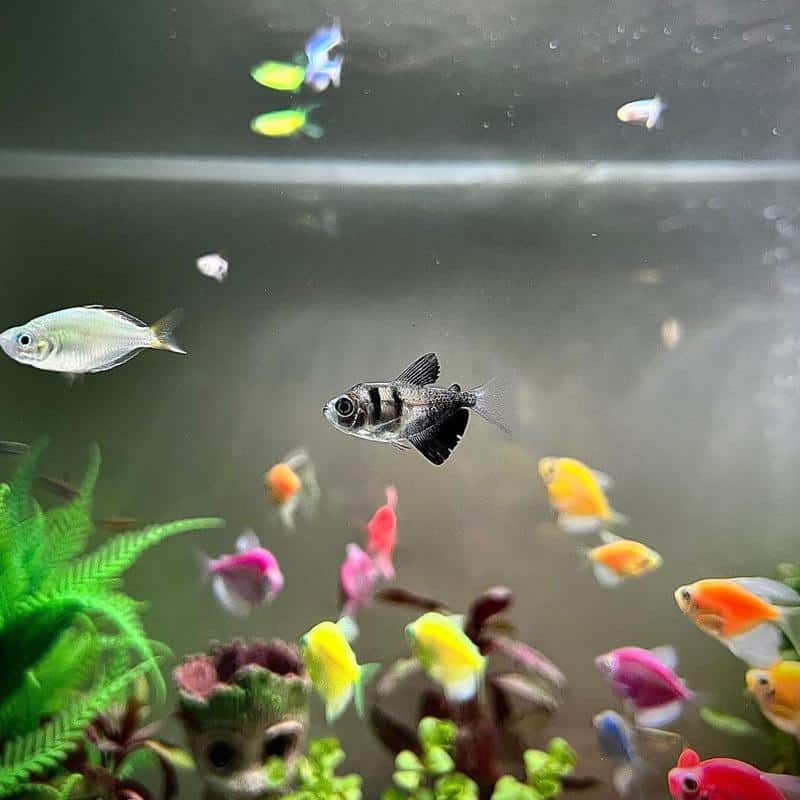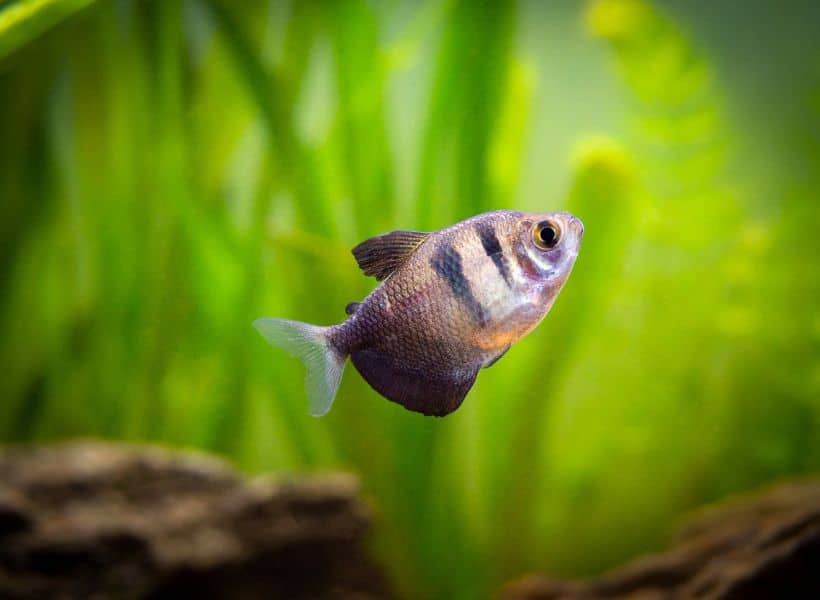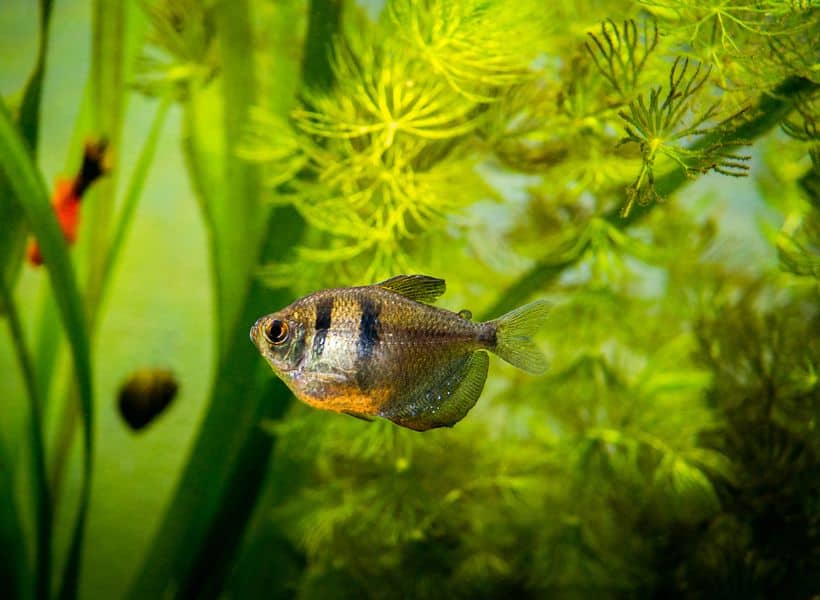The black skirt tetra is one of the most easily recognizable fishes in aquariums around the world. With their distinctive appearance, undemanding nature, and lively personality, it’s easy to see why this fish is such a crowd favorite.
That’s why in this article, we’re going to talk to you about how you can take the best care of your own black skirt tetras!
Black Skirt Tetra Basics
| Physical Traits | Ideal Tank Parameters | ||
| Scientific Name | Gymnocorymbus ternetzi | Water Type | Freshwater |
| Common Names | Black Skirt Tetra, Petticoat Tetra, Blackamoor | Temperature Range | 70°F to 85°F or 21.1-29.4°C |
| Family | Characidae | Water Hardness | 4 to 8 dKH |
| Color | Black and silver | pH Range | 6.0 to 7.5 |
| Size | 1-2.5 inches | Filtration | High filtration levels |
| Care Level | Moderate | Water Flow | Strong water flow |
| Activity Level | Highly active | Ideal Minimum Tank | 15 gallons |
| Diet | Omnivore | Minimum Number | At least 5 |
| Lifespan | 3 to 5 years | Planted Tank | Ideal |
| Behavior | Breeding | ||
| Temperament | Mild | Difficulty to Breed | Moderate |
| Compatibility | Community tank | Spawning Type | Egg scatterers |
| Group Behavior | Schooling | Sexing | Larger and rounder females |
Now that you know all the figures, let’s get to know the more interesting sides of this friendly aquarium fish species!
- They lay thousands of eggs: Black skirt tetras lay and scatter thousands of eggs every spawning season.
- They look fashionable: Black skirt tetras got their names from the distinctive anal fin that follows the length of their body, which looks like a skirt.
- Glowing controversy: The black skirt tetra species also have a GloFish variety that has attracted controversy about animal modification.
- One of the most popular species in the world: Because of their charm and ease of care, tetras such as the black skirt tetra are some of the most popular aquarium fishes around the globe!
- Changing colors: Black skirt tetras will lighten or darken their colors depending on their mood or condition!
Black Skirt Tetra Origins
The black skirt tetra is a naturally occurring fish in Brazil’s Paraguay and Parana River basins. They also have populations around other regional river basins, but you can find many of them here.
This river basin is a lush place renowned for its aquatic biodiversity. Black skirt tetras love blackwater environments characterized by soft, acidic water conditions with tropical to subtropical temperature ranges.
They thrive best in slow-moving tributaries, streams, and flooded areas surrounded by thick vegetation. In this environment, you’ll find plenty of submerged branches and leaf litter, which provide black skirt tetras with shelter and ample hiding spots.
These tetras have adapted to their surroundings of peaceful and community-oriented nature, where they can shoal and interact with other fish species.
Black Skirt Tetra Appearance
The black skirt tetra is one of the world’s most distinctive and popular aquarium fishes. Their unique appearance can be characterized by the following attributes.
- Coloration: The black skirt tetra displays a stunning silver body with a distinct half-black gradient extending from its body’s lower half to the tail. This is also one of the reasons why they’re called Blackamoor or Petticoat tetras.
- Distinctive black bars: Two or three black bars on their front half also pop out among their silvery scales, giving their visage additional aesthetic appeal.
- Body shape: These tetras have a moderately elongated and laterally compressed body shape, giving them a sleek and streamlined appearance in the water.
- Fins: The black skirt tetra boasts elegant dorsal fins complemented with the distinctive and unique long anal fin that follows the length of their body.
- Eye-catching contrast: The contrast between their silver body and the striking black skirt-like markings creates a visually captivating appearance, making them stand out in the aquarium.
Female vs. Male Black Skirt Tetra
Breeding black-skirt tetras can be very easy, but the first step is learning the differences between males and females of this species. The differences can be very slight, but here are what you must watch out for.
- Behavior: Males display more active and attention-seeking behavior, often engaging in courtship displays and chasing females. In contrast, females may be calmer, mainly when preparing to spawn.
- Size: Male black skirt tetras are slightly smaller and more slender than females, with females being slightly larger and plumper due to their reproductive capabilities.
- Fins: Males often have longer and more elaborate anal fins than females. However, the differences might not be evident for some individuals.
Black Skirt Tetra Size
This species of tetra fish can reach a size of 2.5 inches, larger than most beginner hobbyists might expect. Because of their large size and schooling behavior, hobbyists also need to consider having a suitable tank size.
Black Skirt Tetra Lifespan
On average, black skirt tetras have a lifespan of approximately 3 to 5 years in the aquarium. Providing them with a suitable environment, proper nutrition, and regular care can contribute to their overall health and longevity.
Black Skirt Tetra Temperament
Black skirt tetras are known for their generally peaceful and friendly temperament. They typically coexist well with other peaceful community fish, making them an excellent choice for community aquariums.
However, occasional fin nipping may occur if they are kept with long-finned or slow-moving fish, so be careful when considering their tankmates.
Black Skirt Tetra Tank Size

A tank size of at least 15 gallons is ideal for a small group of black skirt tetras. This provides enough swimming space and ensures the fish have ample room to establish territories and exhibit their natural behavior.
That said, you can also get away with 10 gallons if you can stay on top of water changes and regular cleanings.
How Many Black Skirt Tetra per Gallon?
As a general guideline, we recommend having 2 to 3 gallons of water per 1 black skirt tetra. With this in mind, you can put 5-7 individuals inside one 15-gallon tank, the ideal minimum tank size for this species.
However, keep in mind that you also need to consider the requirements and compatibility of other tank mates to maintain a balanced and harmonious aquarium environment.
Also, remember that black skirt tetras are schooling fish, so you’ll need to put them with at least 5 other individuals.
Black Skirt Tetra Tank Setup
You can create the best natural environment for your black skirt tetras by incorporating live plants such as amazon swords, java ferns, or anubias species.
Adding driftwood and rocks mimics their native habitat. Black skirts will also appreciate leaf litter and other natural decor, like what they can find in their natural habitat.
This setup provides the best hiding places, giving them the environment they need to thrive and be at ease.
Aside from that, a good filtration system is also essential to maintain water quality and simulate the steady flow of their natural Brazilian rivers. While the black skirt tetra can tolerate strong water flow, they prefer a nice and gentle current like the ponderous Paraguay river basins.
Black Skirt Tetra Temperature
Maintain a water temperature of 70°F to 85°F or 21.1-29.4°C for black skirt tetras. This temperature range replicates their native tropical habitat, ensuring their utmost comfort and well-being.
Black Skirt Tetra Water Parameters
To create optimal conditions for your black skirt tetras, you should let your water stay slightly acidic or neutral, with a pH range of 6.0 to 7.5. Aim for soft to moderately hard water 4 to 8 dKH.
Regular water changes and a reliable water conditioner will help maintain stable and healthy water parameters for your beloved black skirt tetra pet.
Black Skirt Tetra Diet
black skirt tetras are omnivorous and will accept practically anything you feed them.
In the aquarium, you should offer them a balanced diet of high-quality flake or pellet food supplemented with regular servings of live or frozen foods such as brine shrimp, daphnia, or bloodworms.
Feed your fish what they can eat within a minute, not more than once daily.
Black Skirt Tetra Tank Mates

Black skirt tetras are among the most popular community fishes worldwide because of their striking appearance, hardy nature, and interesting personalities.
However, they still have certain requirements regarding their tank mates because they bully slower-moving fishes or long-finned ones. To help you make the best community aquarium for your tetras, let’s look at this list of the best black skirt tetra tank mates.
- Harlequin Rasbora: The harlequin rasbora is an interesting and active schooling fish with similar water requirements to the black skirt tetra.
- Cherry Barb: Peaceful and colorful, this barb species complements the black skirt tetras with its active behavior and colorful scales.
- Corydoras Catfish: The corydoras is a classic and well-loved bottom-dwelling fish that helps keep the tank clean and adds variety to the aquarium’s activity levels. Shy and peaceful, they will do well with black skirt tetras.
- Zebra Danio: This species is an energetic and fast-swimming fish that can keep up with the active nature of the black skirt tetras.
- Kuhli Loach: Kuhli loaches are peaceful and nocturnal fish occupies the lower levels of your tank and provides interesting behavior and companionship for your black skirt tetra.
- Otocinclus Catfish: Also known as otos, these catfish are renowned for their voracious appetite for algae, which helps control algae growth and contributes to a cleaner aquarium.
- Mystery Snail: This colorful and hardy snail species help with algae control and adds visual appeal to your black skirt tetras.
- Shrimps: Peaceful and fun little shrimps add a certain visual interest to your tank and even assist in keeping the waters nice and clear — something that your black skirt tetras will be profoundly grateful for.
- Celestial Pearl Danio: Small and peaceful fish with beautiful coloration that complements the black skirt tetras in terms of aesthetics.
- Guppies: Vibrant and playful, this elegant aquarium fish species will add vibrant colors and movement when displayed beside your black skirt tetras.
Black Skirt Tetra Common Diseases
A big part of keeping your black skirt tetras happy and healthy is keeping them safe from diseases that will make their daily lives painful.
In this section, we will talk about the most common diseases this fish can suffer from so you know what to look out for in your community aquarium.
Ich (Ichthyophthirius multifiliis)
Ich is a parasitic disease characterized by white spots (like grains of salt) on the fish’s body and fins.
If your black skirt tetra is infected with this parasite, you will notice these bright spots in their scales. They will also exhibit scratching or rubbing against objects in the tank.
Fortunately, ich is a well-known disease with many potential treatments. One of the potentially easy ways to treat it involves raising the water temperature gradually and using an appropriate medication to eradicate the parasite.
Fin Rot (Columnaris)
Columnaris is a bacterial infection that affects the fins, causing them to deteriorate and appear frayed or “rotten.”
Poor water conditions and stress are often the culprits behind it. Symptoms include ragged fins, discoloration, and lethargy.
Treatment of columnaris typically involves improving the environment of your black skirt tetra. You will need to do things like improving water quality, maintaining proper hygiene, and using antibacterial medications.
Velvet Disease
Velvet Disease is a parasitic infection caused by the Oodinium parasite that your black skirt tetra might get from other fishes where they are bred or sold.
Affected fish may exhibit a dark red or dusty appearance, rapid breathing, and scratching against objects.
Velvet disease can be lethal to fish, but it’s not impossible to treat them. Quarantine the affected fish and treat them with appropriate medications such as copper-based or malachite green-based remedies.
Dropsy
Dropsy is not a specific disease but a symptom of underlying issues such as organ failure or bacterial infections.
It’s characterized by your black skirt tetra’s swollen body, raised scales, and bloated appearance. Treatment may involve isolating the affected fish, improving water quality, and administering appropriate medications based on the specific cause.
Swim Bladder Disorder
Swim Bladder Disorder affects the fish’s buoyancy, causing them to struggle with swimming, floating uncontrollably, or sinking to the bottom. The condition may result from overfeeding, poor diet, or bacterial infection.
Treatment involves adjusting the fish’s diet, providing proper nutrition, and maintaining optimal water conditions.
Black Skirt Tetra Breeding
One of the most fulfilling parts of the hobby is breeding your black skirt tetra — and fortunately, it’s often an easy process. Let’s look at how you can enjoy multiplying your beloved pet tetras!
- The first thing you need to do is to set up a separate breeding tank with appropriate hiding spots. Prepare plants or artificial decorations for the female tetras to shelter in and scatter their eggs.
- Introduce a group of well-conditioned adult black skirt tetras, ensuring a ratio of one male to two or three females.
- Provide a balanced diet of high-quality food to condition the breeding pair and stimulate their reproductive behavior.
- Increase the temperature of the breeding tank slightly to around 78-82°F (25-28°C) to mimic their natural breeding conditions.
- The female will scatter eggs among plants or decorations, and the male will fertilize them.
- Remove the adult fish from the breeding tank once spawning is complete to prevent them from consuming the eggs.
- After hatching, the fry will become free-swimming within a few days and can be fed with specialized or crushed flake food.
- Provide hiding places such as fine-leaved plants or floating plants for the fry to seek refuge.
- Perform regular water changes and maintain good water quality to ensure the health and growth of the fry.
- Continue feeding the fry with small, frequent meals of powdered or crushed flake food until they reach maturity.
Also Read:
FAQs
Are Black Skirt Tetras a Good Fish for Beginners?
Black skirt tetras are a good fish for beginners. They’re hardy and easy to care for, as well as visually pleasing. This is especially true in the right environment, and exhibit interesting and fun personalities in your aquarium.
Can Black Skirt Tetras Be Kept with Other Fish?
black skirt tetras are generally peaceful. They can be kept with other peaceful fish of similar size and temperament, such as other tetras, rasboras, or danios. However, be careful because they will often bully slow-moving fishes or fishes with long-flowing fins, so it’s best not to tempt fate.
What Is the Ideal Tank Size for Black Skirt Tetras?
The ideal tank size for black skirt tetras is 15 gallons. This is because black skirt tetras are schooling fish and thrive the most in a group of at least 5 others, and their size makes them need this amount of space. So make sure to factor that into your calculations.
Conclusion
As you can see, black skirt tetras are among the best freshwater aquarium fishes for beginners. They are elegant, interesting, fun, and very easy to care for. Beginner aquarists need only the basics of their care to raise them successfully.
And after this article, you now have all you need to raise your black skirt tetras in the best way possible! We discussed their origin, tank parameters, ideal conditions, breeding process, and more.
All that’s left to enjoy this lovely species in your home is to go out and get them!

